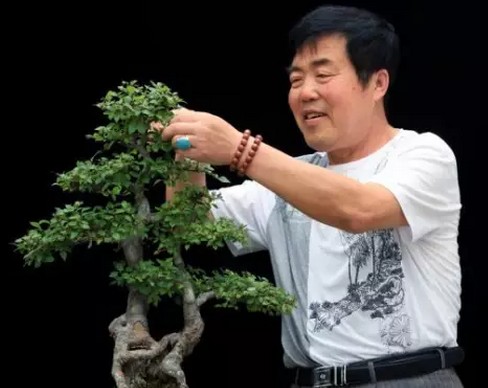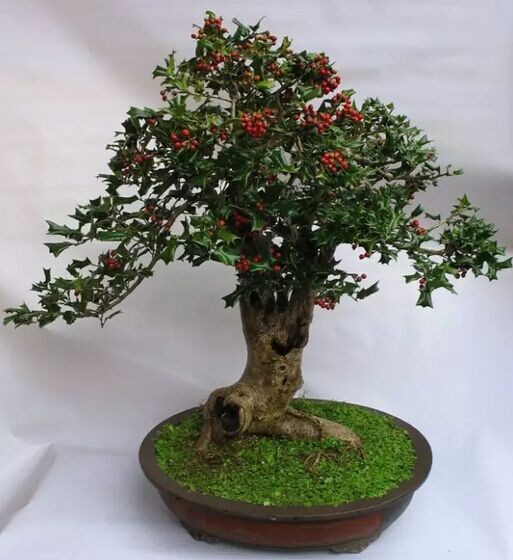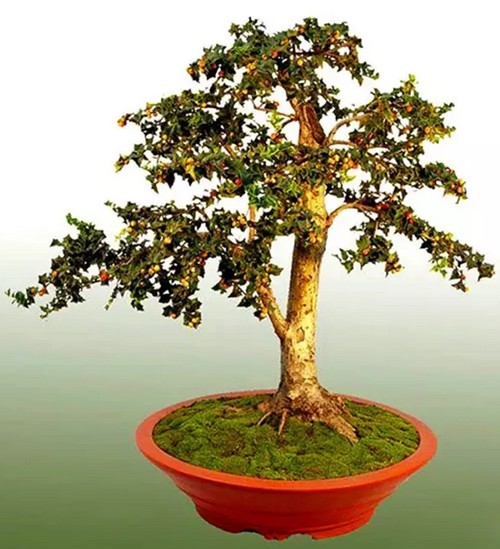Techniques and methods of bonsai pruning
A pot of bonsai stumps with good natural conditions or good natural conditions often grow many new branches. in order to maintain its perfect posture, the bonsai must be often trimmed, otherwise it will gradually lose its hierarchy, resulting in disproportion and tree disorder.

First, prune the useless branches in time. In general, all cross branches, parallel branches, wheel branches (that is, some four-sided whorled branches of the trunk) and all branches that hinder beauty should be cut off at any time, which can not only maintain the original posture of bonsai, but also help to mediate the reasonable supply of water and nutrients, so that bonsai flowers and fruits bloom year after year.
Second, the pruning of broad-leaved tree species. In general, broad-leaf species such as hammer elm, Finch plum, firethorn and other tree species have strong germination. If they are allowed to grow naturally after modeling, many new shoots will appear at the top of the crown. They should be cut flat and trimmed at any time, so that the original level and posture of bonsai can be maintained. This kind of heart-picking work needs to be carried out 3 or 4 times a year. The lateral buds and adventitious buds on the tillers, branches and trunk should be cut off or erased in time after germination.
Third, the pruning of coniferous species. For coniferous species such as Pinus elliottii, Pinus elliottii and Pinus taiwanensis, it is mainly through truncation and sprouting to control the elongation and growth of branches and prevent the foliage from being too dense. After the terminal bud germinates, the new shoots generally grow very fast, often protruding beyond the root crown, so that the tree shape is destroyed. Therefore, in April every year, the main buds on the side branches are removed by hand or all are wiped off; after two weeks, 2 or 5 accessory buds can sprout at the same time where the terminal buds are erased, which disperse the nutrients in the body and grow weakly, so they can maintain a neat and dense crown. The biennial lateral branches should also be properly cut so that several new buds can sprout near the shearing mouth at the same time, which can not only maintain the original level of the crown, but also create a rich, round and natural tree shape.
Fourth, the pruning of bonsai for viewing flowers and fruits. Before pruning, we must first master the flowering and fruiting habits of the tree species. All tree species that bloom on short branches should be re-cut to promote axillary buds to sprout and form short branches; tree species that differentiate flower buds from terminal buds should not be truncated to avoid cutting off flower buds; for tree species that bloom in early spring, the flower buds on the branches are differentiated last year, so they cannot be cut short in spring, and the correct pruning time should be placed after the flowers. Such as: spring, rose, poinsettia, pomegranate, kumquat, crape myrtle, etc. bloom on the branches of the same year, so these bonsai should be heavy-cut in the dormant period, which can increase the flowering of new shade branches. For the spring blooming Shouxing peach, plum blossom, green peach, paste stem begonia and other flowering bonsai blooming on the branches of the second year should be pruned after the flower fade, to promote the germination of new shoots and the formation of second-year flower branches, do not re-cut in the dormant period.
The end face of the cutting mouth should try its best to avoid the tangency between the big face and the branch at an angle of 45 degrees, and the leaf buds remain on the upper side of the oblique mouth. In the growing period, can be posted near the leaf bud pruning, conducive to wound healing. In the non-growing period, it can be pruned at the upper end of the leaf bud.
1. Fixed shears
Fixed shearing, that is, positioning shearing, refers to the first pruning of bonsai modeling, making sure to retain branches in different positions and cut off excess branches. After the tree stumps dug in the mountains survive, they sprout a lot of branches, so they must cut off most of the branches and retain the backbone branches needed for modeling, which is called positioning shears. After positioning cutting, the number and position of branches and the distance between branches are determined, which directly affects the morphological beauty of bonsai trees. Therefore, before pruning, it is necessary to seriously conceive and consider the form of the tree shape. The so-called "intention is to write first". At the same time, you must be "confident" before you can cut it. Because the choice of branches depends on the establishment of the form of tree scenery. The retained branches should grow sturdily, coordinate the thickness of the top and bottom, avoid parallelism, symmetry and overlap as far as possible, be dense and dense, spread around the trunk, and have momentum.
2. Shearing
Pruning is not only a pruning method for shortening branches, but also an important measure for tree modeling and tree landscape maintenance. In terms of modeling, the trees are dwarfed by shearing, the branches are plump, the thickness is variable from top to bottom, and the bending changes, so the modeling should pay attention to three points:
1) the proportion of the thickness transition between the pruned trunk and the upper branch is suitable.
2) when shearing, keep the direction and angle of the bud eye in order to adjust the space position of the new branch.
3) the pruning nodes should be short and long, the first branch is longer than the second branch, and the second branch is longer than the third branch. In terms of maintaining the tree landscape, most of the formed leaves and bonsai need to be shrunk in order to maintain their beauty.
Pine and cypress bonsai mainly rely on sprouting and heart-picking to control super-long branches and maintain their original appearance. On the other hand, different pruning methods should be adopted according to their different growth habits. Such as crape myrtle, pomegranate, begonia and so on, they blossom and bear fruit on the newly drawn branches in the same year, and can be shrunk in the dormant period, but not in the growing period. Yingchun, plum blossom and green peach that blossom in early spring should be pruned after flowering to promote the formation of flower and fruit branches in the following year.
Foliage bonsai can be shrunk twice in early summer and early autumn and strongly cut in the dormant period to remove all kinds of taboo branches. There are many flowers and fruits on the short branches of Hippophae rhamnoides and wolfbone. In addition to strong shearing in the dormant period, the long branches of the same year can also be shrunk in late spring and early summer, and thin fertilizer can be applied frequently to increase light, promote short branches in summer and autumn, and increase the amount of flowers and fruits. Strong pruning during dormancy should keep short branches properly to ensure the flowers and fruits of the following year.
3. Thinning cut
Thinning is to maintain the tree landscape, and can increase ventilation, lighting capacity, reduce the occurrence of diseases and insect pests, nutrient concentration, promote luxuriant branches and leaves, flowers and fruits.
The thinning time varies according to the difference between strong and weak shearing. During the growing period, the branches and leaves are luxuriant and can be cut weakly at any time, but not strongly. Tree species with strong germination, such as sparrow plum and elm, can avoid the rainy season and carry out strong cutting. After cutting, the amount of water should be reduced, thin fertilizer should be applied frequently, and the light should be strengthened. In general, the amount of thinning at the upper end of the tree can be larger, and the amount of thinning at the lower end can be smaller, because the lower branches are more difficult to grow. The objects of thinning are mainly all kinds of taboo branches and overdense branch crowns. When the upper and lower branch crowns are equally important, they should be cut as far as possible, so that the volume of the upper branch crown is smaller than that of the lower branch crown. After thinning and pruning, the growth of the crown is suppressed and many new branches will sprout, which should be cut off in time. Pruning methods include wiping buds, picking hearts, picking leaves, and so on.
1) sprouting: bonsai trees with strong germinating power germinate more and faster in the growing season, so take the trouble to erase all unnecessary buds in time, including root buds, dry buds and axillary buds. At the same time, attention should be paid to preserving the direction, position and density of the buds. In order to avoid sprouting forked branches, opposite branches and overlapping branches, affecting the beauty of the tree.
2) pick the heart: that is, remove the new shoots and tender heads of the trees during the growing period, inhibit the overgrowth of the new shoots, promote the growth of lateral branches, and make the branches shorter, so as to maintain the beauty of the tree shape. The time of coring is different due to the different germination period of different tree species. Leaf wood bonsai, when the new leaf unfolds 2-4 pieces, you can pick the heart. Bonsai of flowers and fruits should be flexibly mastered according to different flower and fruit periods. Coring can stimulate the growth of lateral branches and increase the number of flowers.
3) picking leaves: picking leaves properly can reduce the leaves and improve the ornamental value of bonsai. Some people call this method "strip for brocade". Generally speaking, the new leaves that trees sprout in spring are the most attractive. With the passage of the season, when exposed to the summer sun, the original leaves are bright and bright, and they gradually become old and autumn. By picking leaves, they can send out fresh and tender new leaves again. Add the best ornamental effect. Some old piles, iron branches dry, towering iron bones, and new leaves such as green, green, spring is full of vitality. The time of picking leaves varies from tree species to tree species, and leaf trees can pick leaves in early summer or early autumn. Evergreen trees are not suitable for picking leaves. During the period of picking leaves, water should be properly deducted, and the basin soil should not be too damp. In addition, rotten cake fertilizer and water should be frequently applied to strengthen ventilation and light to promote the germination of new leaves.
Time: 2019-06-13 Click:
- Prev

Pruning and pose technique of medlar bonsai
Dog bone is Chinese wolfbone, scientific name: Ilexcornuta, also known as cat thorn, tiger thorn, star anise thorn, bird not overnight, dog bone thorn, cat incense, mouse tree, etc., is an evergreen shrub or small tree, the leaf shape is strange, green and bright, evergreen all the year round, the red fruit is full of branches after autumn, does not wither through winter, gorgeous and lovely
- Next

Cultivation technique of bonsai with Chinese wolfberry
Chinese wolfbone, also known as tiger thorn, cat thorn, bird not sleeping and so on, is a common landscape tree species, which is often used in landscape design and urban greening. However, because Chinese wolfberry has high ornamental value, many people now use it for bonsai art modeling and potted culture.
Related
- Fuxing push coffee new agricultural production and marketing class: lack of small-scale processing plants
- Jujube rice field leisure farm deep ploughing Yilan for five years to create a space for organic food and play
- Nongyu Farm-A trial of organic papaya for brave women with advanced technology
- Four points for attention in the prevention and control of diseases and insect pests of edible fungi
- How to add nutrient solution to Edible Fungi
- Is there any good way to control edible fungus mites?
- Open Inoculation Technology of Edible Fungi
- Is there any clever way to use fertilizer for edible fungus in winter?
- What agents are used to kill the pathogens of edible fungi in the mushroom shed?
- Rapid drying of Edible Fungi

